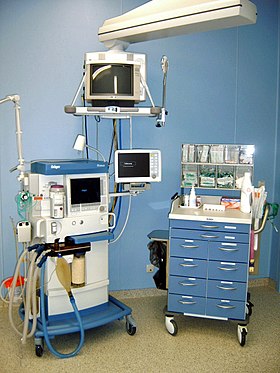
Back تخدير عام Arabic Narkoz Azerbaijani Наркоз Byelorussian Наркоз BE-X-OLD Anestèsia general Catalan Universel anæstesi Danish Narkose German Narkozo Esperanto Anestesia general Spanish Anestesia orokor Basque
This article needs additional citations for verification. (February 2015) |
| General anaesthesia | |
|---|---|
 Equipment used for anaesthesia in the operating room | |
| Specialty | Anaesthetics |
| Uses | Facilitating surgery, terminal sedation[1] |
| Complications | Anaesthesia awareness,[2] overdose,[3] death[4] |
| MeSH | D000768 |
| MedlinePlus | 007410 |
General anaesthesia (UK) or general anesthesia (US) is a method of medically inducing loss of consciousness that renders a patient unarousable even with painful stimuli.[5] This effect is achieved by administering either intravenous or inhalational general anaesthetic medications, which often act in combination with an analgesic and neuromuscular blocking agent. Spontaneous ventilation is often inadequate during the procedure and intervention is often necessary to protect the airway.[5] General anaesthesia is generally performed in an operating theater to allow surgical procedures that would otherwise be intolerably painful for a patient, or in an intensive care unit or emergency department to facilitate endotracheal intubation and mechanical ventilation in critically ill patients. Depending on the procedure, general anaesthesia may be optional or required. Regardless of whether a patient may prefer to be unconscious or not, certain pain stimuli could result in involuntary responses from the patient (such as movement or muscle contractions) that may make an operation extremely difficult. Thus, for many procedures, general anaesthesia is required from a practical perspective.
A variety of drugs may be administered, with the overall goal of achieving unconsciousness, amnesia, analgesia, loss of reflexes of the autonomic nervous system, and in some cases paralysis of skeletal muscles. The optimal combination of anesthetics for any given patient and procedure is typically selected by an anaesthetist, or another provider such as a nurse anaesthetist (depending on local practice and law), in consultation with the patient and the surgeon, dentist, or other practitioner performing the operative procedure.[6]
- ^ Takla, A; Savulescu, J; Wilkinson, DJC; Pandit, JJ (October 2021). "General anaesthesia in end-of-life care: extending the indications for anaesthesia beyond surgery". Anaesthesia. 76 (10): 1308–1315. doi:10.1111/anae.15459. PMC 8581983. PMID 33878803.
- ^ Cite error: The named reference
Budworth2019was invoked but never defined (see the help page). - ^ Cite error: The named reference
Hewer_1937was invoked but never defined (see the help page). - ^ Cite error: The named reference
Dewachter2009was invoked but never defined (see the help page). - ^ a b "Position on Monitored Anesthesia Care" (PDF). American Society of Anesthesiologists. Archived from the original (PDF) on 11 November 2022. Retrieved 6 November 2022.
Approved by the House of Delegates on October 25, 2005, and last amended on October 17, 2018
- ^ Cite error: The named reference
:11was invoked but never defined (see the help page).